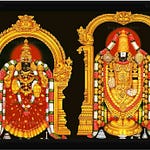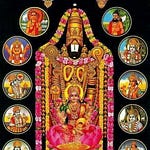Verse 28 is the penultimate verse of the Śrī Veṅkaṭeśa Suprabhātam. Penultimate verses, especially from Swāmī Vedānta Deśikar’s time onwards, are typically particularly significant in Śrīvaiṣṇava compositions: they are known as dhyāna-ślokas (“verses for contemplation”), and typically either paint a vivid visual image of the deity for contemplation or capture the essence of the whole composition. This verse of the Suprabhātam is especially lovely, because despite its extremely simple structure (it is just a sequence of names of Lord Śrīnivāsa), it synthesizes the entire Śrīvaiṣṇava tradition.
[1] Lakṣmī-nivāsa! [2] niravadya-guṇaîka-sindho! [3] saṃsāra-sāgara-samuttaraṇaîka-seto! | [4] Vedânta-vedya-nija-vaibhava! [5] bhakta-bhogya! [6] Śrī-Veṅkaṭâcala-pate! tava suprabhātam || (VSu 28) लक्ष्मी-निवास ! निरवद्य-गुणैक-सिन्धो ! संसार-सागर-समुत्तरणैक-सेतो ! वेदान्त-वेद्य ! निज-वैभव-भक्त-भोग्य ! श्रीवेङ्कटाचल-पते! तव सुप्रभातम् ॥
[1] O abode of the Supreme Goddess Lakṣmī! [2] O ocean of purely flawless, unassailable virtues! [3] O sole bridge that can help us cross the sea of saṃsāra! [4] O Lord whose glories are knowable through the Vedānta! [5] O Lord relished by Your devotees! [6] O Lord of the sacred mountain wealth-weaving, sin-cleaving Veṅkaṭam, a blessed morning unto You!
Since this verse is explicitly meant to be contemplated upon, I will keep my commentary relatively brief, so as to allow you, Gentle Reader, to ponder over the verse and come up with your own interpretations.
The six names of the Lord
Let us now look at the six names of Lord Śrīnivāsa listed here.
Lakṣmī-nivāsa
The first name, Lakṣmī-nivāsa, is a rephrasing of the Lord’s name Srinivasa. This is a name we have seen before, and it is one of the most beautiful names for God as it underscores the eternal unity of the Divine Masculine and the Divine Feminine.
From a temple iconic perspective, this name emphasizes that Lord Śrīnivāsa’s broad chest is the dwelling-place for Mahālakṣmī. As Nammāḻvār describes Him in the opening of one of his most beautiful pāsurams, dedicated entirely to Lord Veṅkaṭeśvara (Tiruvāymŏḻi 6.10 (Ulagam uṇḍa). 10):
agalagillēn iṟaiyum ĕṉḏṟu Alar-mēl-maṅgai urai mārbā! (TVM 6.10.10a)
O Lord upon whose chest dwells the Goddess who sits upon the lotus, saying: “I will never be separated from You, not even for an instant”!
It is surely no coincidence that this pāsuram is also the penultimate verse of Nammāḻvār’s decad, and similarly begins with an evocation of the Lord as the Goddess’s dwelling-place.
It is also no coincidence that Aṇṇan Swāmī’s verse begins with the evocation of Mahālakṣmī, given Her central role in the Śrīvaiṣṇava tradition both as the Divine Feminine as well as the ever-loving Divine Mother who unfailingly intercedes on our behalf with the Lord.
Niravadya-guṇaîka-sindhu
We have also repeatedly seen the comparison of Lord Śrīnivāsa’s qualities to an ocean throughout the Suprabhātam. The Śrīvaiṣṇava tradition accepts that the Divine is saguṇa (endowed with qualities), and specifically all positive qualities and exclusively positive qualities.
Saṃsāra-sāgara-samuttaraṇaîka-setu
Juxtaposed with the oceanic imagery is the image of the Divine as a bridge across a sea—this time, the sea of saṃsāra in which all beings are constantly bobbing up and down, if not drowning in the depths. The Lord who is eternally united with His Lady is the sole means (upāya) of escape from this sea, which is why They are described as the sole bridge that crosses it.
Vedānta-vedya-nija-vaibhava
And how are we to know these things? What is the source of knowledge about the nature and the glories of the Divine Duo? The verse tells us cleanly: not observation, not inference, but the holy words of the three-fold Vedānta—the Upaniṣads, the Brahma-sūtras of Vyāsa Bādarāyaṇa, and the Śrīmad Bhagavad-Gītā—as properly understood through the commentaries of Swami Ramanujar and the subcommentaries of later Ācāryas like Swāmī Deśikar.
To the Sanskrit Vedānta Śrīvaiṣṇavas also add the Tamil Veda: the 4000 verses in Tamil that constitute the Divya-Prabandham, with special emphasis upon the Tiruvāymŏḻi of Nammāḻvār.1 These texts then tell us about the nija-vaibhavas, the unique powers and glories of the Lord that are not applicable to anybody else, and that alone make Him our goal.
Bhakta-bhogya
Finally, the last unique name in this verse, bhakta-bhogya, is highly significant because it tells us how we, equipped with the right knowledge, can correctly relate to the Divya Dampati: We can relish Them, enjoy Them through all of Their wealth and glory and adornments as displayed in Their temples, Their stories and songs, and also through the beauties of this world which is Their creation of play or līlā-vibhūti.
This quality of the Lord is also the primary message of the second centad of the Tiruvāymŏḻi, as per Swāmī Deśikar’s Sanskrit distillation of the TVM in his Dramiḍôpaniṣat-tātparya-ratnāvalī: In verse 8, where he describes every centad with a single word, he uses the word bhogya-bhāvāt (“owing to His being enjoyable”) to describe the second centad in particular.
An implicit Śrīvaiṣṇava catechism
We can thus treat verse 28 as a catechism of the Śrīvaiṣṇava samprādaya, with each name being an answer to an implicit question:
Who is the Supreme Divinity?
It is Śrīman-Nārāyaṇa: the Lord whose chest is the eternal abode for Mahālakṣmī; hence Lakṣmī-nivāsa.What is the nature of the Supreme Divinity?
The unlimited storehouse of all, and exclusively only, positive qualities, and thus free of even the slightest whiff of anything negative; hence niravadya-guṇaîka-sindhu.Why worship the Supreme Divinity?
Because They Themselves are the only way to overcome the world of saṃsāra, as well as being the sole goal; hence saṃsāra-sāgara-samuttaraṇaîka-setu.How can we know the Supreme Divinity?
Through the Vedānta (both Sanskrit and Tamil), revealed to us by the Divine in order to reach the Divine, which tells us all about the glories and the magnificence of the Divine; hence Vedānta-vedya-nija-vaibhava.How can we worship the Divine?
By enjoying and celebrating the Divine's manifested glory and magnificence in the company of other devotees to whom the Lord and Lady have made Their glory manifest; hence bhakta-bhogya,Where can we find the Divine?
In Tiru-Veṅkaṭam (among other sacred sites or divya-deśas), on top of the hill, as Lord Śrīnivāsa who is eternally associated with His śrī, the Lady Padmāvatī Tāyār; hence Śrī-Veṅkaṭâcala-pati.
|| Śrī-Padmāvatī-nāyikā-sameta-Śrī-Śrīnivāsa-parabrahmaṇe namaḥ ||
As the second half of the Sanskrit taniyan recited before the recitation of the Tiruvāymŏḻi describes it:
sahasra-śākhôpaniṣat-samāgamaṃ
namāmy aham Drāviḍa-Veda-sāgaram ||I bow down to the ocean that is the Tamil Veda, the confluence of the thousand streams of the Upaniṣads.
This verse can be understood both as describing the Tiruvāymŏḻi as the Tamil equivalent of the Sāma Veda (known for its thousand śākhās, or recensions). However, given the use of the word upaniṣat in the verse, I would highlight the esoteric nature of the text and the existence of a number of layers of meaning in the Tiruvāymŏḻi that can only be elucidated through long study and instruction by gurus—much like the Upaniṣads themselves.









Share this post